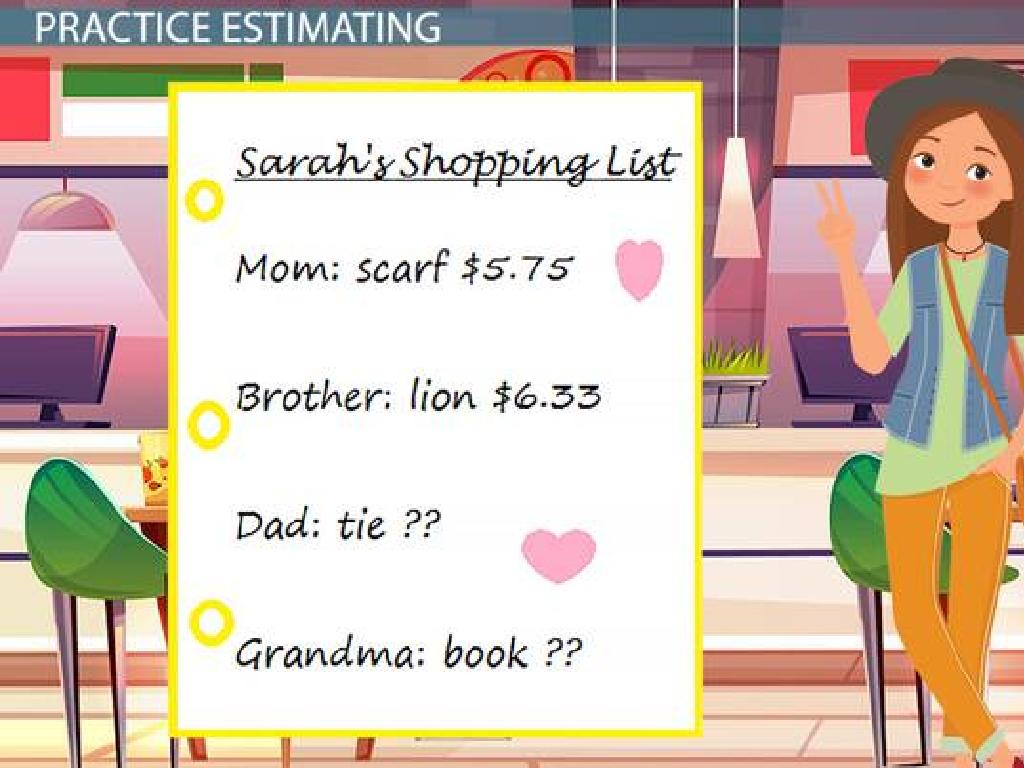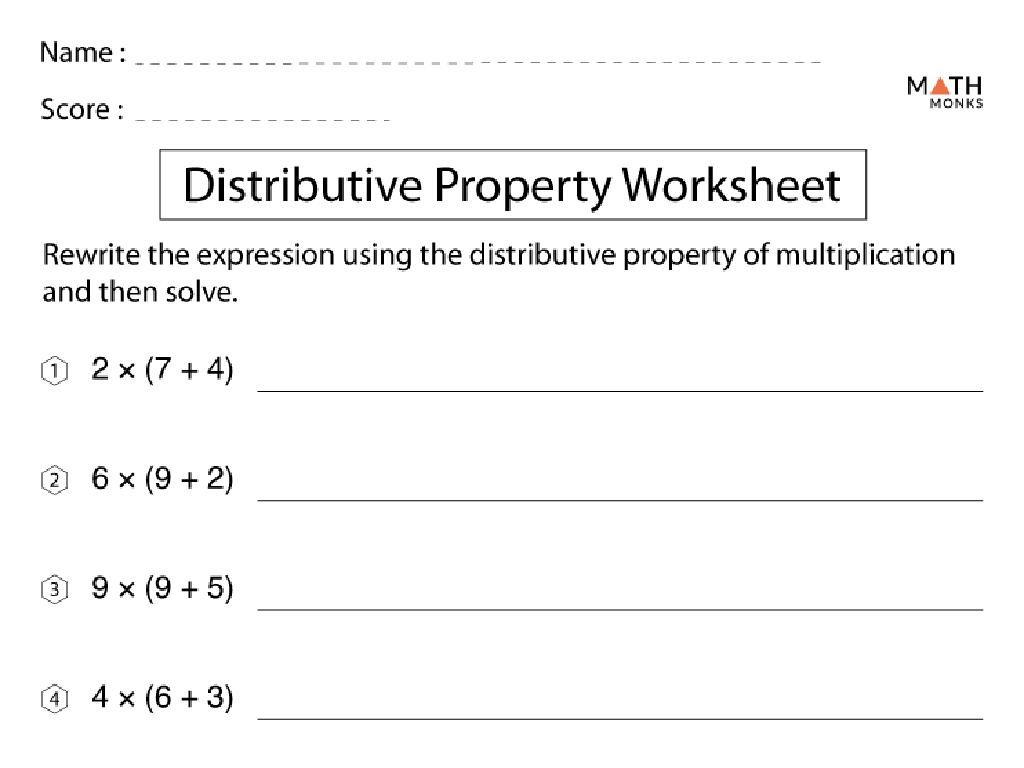Add And Subtract Mixed Numbers: Word Problems
Subject: Math
Grade: Fifth grade
Topic: Add And Subtract Mixed Numbers
Please LOG IN to download the presentation. Access is available to registered users only.
View More Content
Introduction to Mixed Numbers
– Whole numbers vs. fractions
– Whole numbers are complete, fractions are parts.
– Defining mixed numbers
– Mixed numbers combine whole numbers and fractions.
– Mixed numbers in daily life
– Use in cooking, measuring, and time tracking.
– Practice with real examples
|
This slide introduces the concept of mixed numbers, which are essential in understanding more complex mathematical operations. Begin by explaining the difference between whole numbers and fractions, ensuring that students are comfortable with each concept separately. Then, define mixed numbers as the sum of a whole number and a fraction. Provide relatable examples such as using mixed numbers in recipes for cooking, measurements in building, or keeping track of time. Encourage students to think of other areas where they encounter mixed numbers. Conclude with practice problems that apply mixed numbers to real-life situations, reinforcing their understanding through application.
Visualizing Mixed Numbers with Pie Charts
– Pie charts show mixed numbers
– Each pie chart slice represents a fraction of a whole
– Convert improper fractions
– Change fractions greater than a whole into mixed numbers
– Identify mixed numbers visually
– Use pie charts to recognize and name mixed numbers
– Practice with pie charts
|
This slide introduces students to the concept of visualizing mixed numbers using pie charts, which can make understanding these numbers more intuitive. Start by explaining that each slice of the pie chart can represent a fraction and a whole pie is like a whole number. Show how to convert improper fractions (where the numerator is larger than the denominator) into mixed numbers. Provide examples of pie charts and ask students to identify the mixed numbers they represent. For practice, give students pie charts with different fractions shaded and have them write the corresponding mixed numbers. This visual method helps solidify the concept of mixed numbers as parts of wholes.
Adding Mixed Numbers
– Steps to add mixed numbers
– Convert to improper fractions, find common denominators, add and simplify.
– Example with like denominators
– 2 1/3 + 3 1/3 = ? Convert to improper fractions (7/3 + 10/3), add (17/3), convert back (5 2/3).
– Example with unlike denominators
– 1 2/5 + 2 4/7 = ? Find common denominator (35), convert (7/35 + 8/35), add (15/35), simplify (3/7).
|
This slide introduces the process of adding mixed numbers, which is a key skill in fifth-grade math. Begin by explaining the steps to add mixed numbers: converting mixed numbers to improper fractions, finding a common denominator, adding the fractions, and simplifying the result if possible. Use the examples to illustrate these steps with like and unlike denominators. For like denominators, show that you can simply add the fractions. For unlike denominators, demonstrate finding a common denominator before adding. Encourage students to practice these steps with additional problems and ensure they understand how to simplify their answers.
Subtracting Mixed Numbers
– Steps to subtract mixed numbers
– Convert to improper fractions, subtract, simplify
– Example with like denominators
– 3 1/4 – 2 1/4 = 1 (same denominator, subtract whole numbers and fractions)
– Example with unlike denominators
– 4 2/3 – 2 1/6: Find common denominator, convert, subtract, simplify
– Practice with word problems
|
This slide introduces the concept of subtracting mixed numbers, a key skill in fifth-grade math. Start by explaining the steps to convert mixed numbers to improper fractions, perform the subtraction, and then simplify the result. Provide an example with like denominators to show the simpler case, then move on to an example with unlike denominators, emphasizing the need to find a common denominator first. Conclude with a prompt for students to practice with word problems, applying what they’ve learned. The teacher should prepare several word problems of varying difficulty for the students to solve, ensuring they understand the concept thoroughly.
Word Problems with Mixed Numbers
– Understand the word problem
– Read carefully to grasp the scenario.
– Decide to add or subtract
– Look for keywords: ‘total’, ‘left’, ‘more’ to choose operation.
– Solve the problem step by step
– Break into whole numbers and fractions, then compute.
– Check your answer
– Review your solution to ensure it makes sense.
|
This slide is aimed at guiding fifth-grade students through the process of solving word problems involving the addition and subtraction of mixed numbers. Start by reading the problem thoroughly to understand the context and what is being asked. Teach students to identify keywords that signal whether to add or subtract. For example, ‘in total’ or ‘combined’ suggest addition, while ‘left’ or ‘remaining’ suggest subtraction. Encourage them to solve problems by separating whole numbers from fractions for easier computation. Finally, remind them to check their answers by reviewing the problem and ensuring the solution is reasonable within the context. Provide several practice problems for students to apply these steps independently.
Mixed Numbers: Practice Problems
– Solve problems as a class
– Discuss problem-solving strategies
– Break down steps: estimate, calculate, check
– Q&A session for doubts
– Ask questions if you’re unsure about the process
– Reinforce learning with examples
– Use examples like pizza slices or measuring cups
|
This slide is designed to engage students in active problem-solving with mixed numbers. Start by working through practice problems together, encouraging participation from the class. Discuss strategies such as estimating the answer first, carefully performing calculations, and then checking the work. Open the floor for a Q&A session, allowing students to ask questions and clarify any points of confusion. Use relatable examples, such as dividing pizza slices or using measuring cups, to help students visualize the problems. The goal is to solidify their understanding of adding and subtracting mixed numbers through practice and discussion.
Class Activity: Mixed Numbers Scavenger Hunt
– Find classroom objects as mixed numbers
– Create word problems with objects
– Use objects to form problems like, ‘If you have 2 1/2 erasers, and you find 1 3/4 more, how many do you have?’
– Exchange problems with classmates
– Solve each other’s mixed number problems
– Practice addition and subtraction of mixed numbers through peer problems
|
This interactive activity is designed to help students understand mixed numbers in a fun and engaging way. Students will search the classroom for items that can be represented as mixed numbers, such as a pile of books with a bookmark halfway through one, symbolizing a mixed number like 5 1/2. They will then create their own word problems based on these objects, which helps in applying their knowledge of mixed numbers to real-world scenarios. After creating their problems, students will exchange their problems with classmates to solve. This peer-to-peer activity not only reinforces their understanding but also allows them to see different approaches to problem-solving. As a teacher, circulate the room to assist with problem creation and ensure the problems are appropriate for the class level. Possible variations of the activity could include a timed challenge, team collaboration, or presenting solutions to the class for discussion.
Wrapping Up: Mixed Numbers
– Review adding & subtracting mixed numbers
– Understand practice significance
Regular practice solidifies understanding.
– Real-life application of mixed numbers
Used in cooking, construction, and more.
– Homework: Mixed Numbers Worksheet
Solve word problems involving mixed numbers.
|
As we conclude today’s lesson on adding and subtracting mixed numbers, it’s crucial to emphasize the importance of practice in mastering these concepts. Highlight how mixed numbers are used in everyday life, such as in measuring ingredients for a recipe or determining the length of materials needed for a building project. For homework, students will complete a worksheet that includes word problems involving mixed numbers, which will help them apply what they’ve learned in class to practical scenarios. Encourage students to attempt the problems independently, and remind them to bring any questions they have to the next class for clarification.






